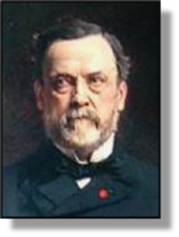 xxxxxAs we have seen, it was in 1858
(Va) that the outstanding French chemist
and microbiologist Louis Pasteur began to study the process of
fermentation in the making of wine. He discovered that this was
caused by microorganisms, and from this finding came the method
known as “pasteurisation”, a controlled heating process for
destroying harmful microscopic life. Further experiments convinced
him that diseases were spread by germs contained in particles of
dust. His theory - one of the most important contributions to
medical science ever made - was proven in 1865
(Vb). It was then that, tasked with
saving the French silkworm industry, he discovered that the
virulent disease which was affecting the silkworms was caused by a
tiny parasite. He destroyed all the infected worms and the leaves
they fed on, and re-established a thriving industry based on
healthy worms.
xxxxxAs we have seen, it was in 1858
(Va) that the outstanding French chemist
and microbiologist Louis Pasteur began to study the process of
fermentation in the making of wine. He discovered that this was
caused by microorganisms, and from this finding came the method
known as “pasteurisation”, a controlled heating process for
destroying harmful microscopic life. Further experiments convinced
him that diseases were spread by germs contained in particles of
dust. His theory - one of the most important contributions to
medical science ever made - was proven in 1865
(Vb). It was then that, tasked with
saving the French silkworm industry, he discovered that the
virulent disease which was affecting the silkworms was caused by a
tiny parasite. He destroyed all the infected worms and the leaves
they fed on, and re-established a thriving industry based on
healthy worms.
xxxxxHis germ
theory of disease did not convince all. Sceptics remained for many
years, and his work came in for a great deal of adverse criticism
and ridicule at times. However, by the 1880s the majority of
doctors and surgeons, like the Englishman Joseph Lister, were
taking antiseptic precautions to stop the spread of disease
carried in the atmosphere - such as boiling instruments and
using chemical disinfectants. By that time, however, Pasteur had
turned his attention to preventative medicine. When studying a
particular disease, he told an audience in 1884, he did not think
of finding a remedy but, more importantly, the means by which it
could be prevented. As early as 1880, while investigating fowl
cholera - a highly contagious condition - he discovered
that, by employing a process similar to that used by the English
physician Edward Jenner - who had discovered a vaccine
against cowpox back in 1796 (G3b) - he could give the birds immunity from the
disease by inoculating them with a weakened form of the germ. He
concluded that the weak strain had enabled each bird to form a
defence against an even more powerful attack of the disease. And
this further explained why animals which had been stricken with a
disease but had managed to recover from it also became immune to
further attacks.
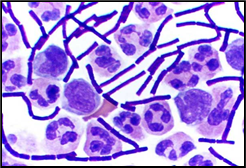 xxxxxThe following year Pasteur turned to the study of
anthrax, an acute disease which is primarily a disease of grazing
animals - such as cattle, sheep and horses - but can
also affect humans. His rival in this field, the German
bacteriologist Robert Koch had discovered the rod shaped anthrax
bacilli (illustrated)
and made his findings known in 1876. Pasteur experimented further
with Koch’s bacilli. By subjecting them to heat over varying periods
of time he eventually managed to isolate a weakened strain which
could serve as a workable vaccine. Then in May 1881,
having had his findings challenged by Hippolyte Rossignol, the
editor of The Veterinary Press, he staged
a public demonstration of this vaccine. He injected a number of
sheep and cows with the attenuated (weakened) culture, and left a
similar number untreated. Four weeks later he injected all the
animals with a powerful anthrax culture, and within a space of three
days all the untreated animals had died. By contrast, the inoculated
group suffered no ill-effects and were described as being “in
perfect health”.
xxxxxThe following year Pasteur turned to the study of
anthrax, an acute disease which is primarily a disease of grazing
animals - such as cattle, sheep and horses - but can
also affect humans. His rival in this field, the German
bacteriologist Robert Koch had discovered the rod shaped anthrax
bacilli (illustrated)
and made his findings known in 1876. Pasteur experimented further
with Koch’s bacilli. By subjecting them to heat over varying periods
of time he eventually managed to isolate a weakened strain which
could serve as a workable vaccine. Then in May 1881,
having had his findings challenged by Hippolyte Rossignol, the
editor of The Veterinary Press, he staged
a public demonstration of this vaccine. He injected a number of
sheep and cows with the attenuated (weakened) culture, and left a
similar number untreated. Four weeks later he injected all the
animals with a powerful anthrax culture, and within a space of three
days all the untreated animals had died. By contrast, the inoculated
group suffered no ill-effects and were described as being “in
perfect health”.
 xxxxxIn April 1882 Pasteur was elected a member of the Académie Française, and it was then that he
began his research to find a preventative treatment for rabies, a
deadly virus which causes inflammation of the brain in warm-blooded
animals, and can be passed onto humans from bites or scratches
from an infected animal. Known in humans as “hydrophobia”, it is
invariably fatal. He began his investigation by studying the
saliva of an animal suffering from rabies and then, by a series of
injections, he established that the disease (a virus in fact) was
also present in the nervous system. Then, using the dry tissue of
infected animals, particularly rabbits, he eventually obtained a
weakened form of the virus which he considered to be safe for
injection into humans. But the test as to
its safety came sooner than expected when, in July 1885, a nine-year
old boy who had been bitten by a rabid dog was brought to him for
treatment. Because in the case of rabies there was a delay before
the virus reached the brain, it was possible to give the vaccine
after the bite had occurred. However, because the vaccine had not
been fully proven, Pasteur hesitated. Then eventually, in view of
the boy’s condition, he carried out the injection and, against all
odds, the boy survived.
xxxxxIn April 1882 Pasteur was elected a member of the Académie Française, and it was then that he
began his research to find a preventative treatment for rabies, a
deadly virus which causes inflammation of the brain in warm-blooded
animals, and can be passed onto humans from bites or scratches
from an infected animal. Known in humans as “hydrophobia”, it is
invariably fatal. He began his investigation by studying the
saliva of an animal suffering from rabies and then, by a series of
injections, he established that the disease (a virus in fact) was
also present in the nervous system. Then, using the dry tissue of
infected animals, particularly rabbits, he eventually obtained a
weakened form of the virus which he considered to be safe for
injection into humans. But the test as to
its safety came sooner than expected when, in July 1885, a nine-year
old boy who had been bitten by a rabid dog was brought to him for
treatment. Because in the case of rabies there was a delay before
the virus reached the brain, it was possible to give the vaccine
after the bite had occurred. However, because the vaccine had not
been fully proven, Pasteur hesitated. Then eventually, in view of
the boy’s condition, he carried out the injection and, against all
odds, the boy survived.
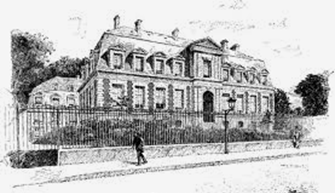 xxxxxThexsuccessful production of
a vaccine against rabies led directly to the founding of the Pasteur Institute in Paris,
dedicated to the treatment of infectious diseases and, today, one
of the most famous centres of biological research. Built with
money received from public subscriptions, raised worldwide, it was
opened in 1888, and Pasteur served as its director until his death
in 1895. With the assistance of a well-trained team, and
serving mainly in an advisory capacity, he spent the remaining
years of his life searching for the means by which diseases such
as septicaemia, diphtheria, tuberculosis and smallpox could be
prevented by vaccination.
xxxxxThexsuccessful production of
a vaccine against rabies led directly to the founding of the Pasteur Institute in Paris,
dedicated to the treatment of infectious diseases and, today, one
of the most famous centres of biological research. Built with
money received from public subscriptions, raised worldwide, it was
opened in 1888, and Pasteur served as its director until his death
in 1895. With the assistance of a well-trained team, and
serving mainly in an advisory capacity, he spent the remaining
years of his life searching for the means by which diseases such
as septicaemia, diphtheria, tuberculosis and smallpox could be
prevented by vaccination.
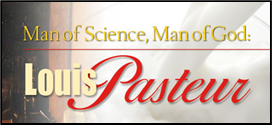 xxxxxPasteur died at Saint-Cloud in the western
suburbs of Paris in September 1895. A national hero with many
honours to his credit, he was given a state funeral at Notre Dame
Cathedral and buried in a crypt at the Pasteur Institute. Pasteur,
a modest man who dedicated his life to the benefit of others, was,
without doubt, one of the greatest medical scientists of all time.
Quite apart from his introduction of “pasteurisation”, a method
which saved thousands of lives and proved of such economic
benefit, and the advances he made in providing vaccines for a
number of deadly diseases, his discovery of the germ theory of
disease proved the single most important contribution ever made to
the advancement of medical science. Today he is recognised as the
man whose painstaking work saved the greatest number of human
lives.
xxxxxPasteur died at Saint-Cloud in the western
suburbs of Paris in September 1895. A national hero with many
honours to his credit, he was given a state funeral at Notre Dame
Cathedral and buried in a crypt at the Pasteur Institute. Pasteur,
a modest man who dedicated his life to the benefit of others, was,
without doubt, one of the greatest medical scientists of all time.
Quite apart from his introduction of “pasteurisation”, a method
which saved thousands of lives and proved of such economic
benefit, and the advances he made in providing vaccines for a
number of deadly diseases, his discovery of the germ theory of
disease proved the single most important contribution ever made to
the advancement of medical science. Today he is recognised as the
man whose painstaking work saved the greatest number of human
lives.
xxxxxIncidentally, Pasteur’s life was not without its hardship and
tragedy. He was brought up with a mentally retarded sister, and he
saw three of his five children die of infant diseases. And during
his lifetime he suffered from
several strokes, one of which left him partially paralysed at the
age of 46. This hampered his work but never stopped it. As a
dedicated Christian, he rejected Darwin’s theory of evolution and
believed, on the contrary, that science brought man nearer to God.
This unswerving faith sustained him throughout his life. ……
xxxxx…… Duringxhis early research
Pasteur was ably assisted by the French bacteriologist Pierre Roux (1853-1933).
He began working for Pasteur in 1879 and took part in developing
vaccines for fowl cholera, anthrax and rabies. Later he worked on
vaccines for syphilis and tetanus, and in 1889, together with the
French-Swiss bacteriologist Alexandre Yersin, he discovered
the diphtheria toxin. He joined the staff of the Pasteur Institute
in 1888, and was the director of the Institute from 1904 until his
death.
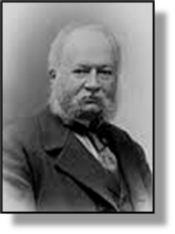 xxxxxAs we have seen, it was in the 1860s that Pasteur
saved the French silk industry from extinction by finding and
eradicating a harmful parasite. In the 1880s, however, the
industry was again threatened. In 1878 the French chemist Hilaire de Chardonnet (1839-1924)
who, ironically, had worked with Pasteur during his research into
silkworms, knocked over a bottle of nitrocellulose and noticed
that, due to evaporation, the contents had developed into long
thin strands of fibre, very similar in strength and appearance to
silk. Working with mulberry leaves - the food of the silkworm
- he turned them into a cellulose pulp by using a combination
of nitric and sulphuric acids and then stretched the material into
fibres. In 1884 he received the first patent for artificial silk (to become known as rayon
in the 1920s ), and he exhibited his invention at the Paris
Exhibition of 1889. Having treated the material to reduce its
flammability, he began manufacturing his “Chardonnet silk” in
1891, the first synthetic fibre to go on the market.
xxxxxAs we have seen, it was in the 1860s that Pasteur
saved the French silk industry from extinction by finding and
eradicating a harmful parasite. In the 1880s, however, the
industry was again threatened. In 1878 the French chemist Hilaire de Chardonnet (1839-1924)
who, ironically, had worked with Pasteur during his research into
silkworms, knocked over a bottle of nitrocellulose and noticed
that, due to evaporation, the contents had developed into long
thin strands of fibre, very similar in strength and appearance to
silk. Working with mulberry leaves - the food of the silkworm
- he turned them into a cellulose pulp by using a combination
of nitric and sulphuric acids and then stretched the material into
fibres. In 1884 he received the first patent for artificial silk (to become known as rayon
in the 1920s ), and he exhibited his invention at the Paris
Exhibition of 1889. Having treated the material to reduce its
flammability, he began manufacturing his “Chardonnet silk” in
1891, the first synthetic fibre to go on the market.
xxxxxMeanwhile two
English chemists, Charles Cross (1855-1935) and Edward
Bevan (1856-1921), having formed a
partnership in 1885, set up a chemical business in London. There
they carried out research into the organic compound called
cellulose, and in 1892 took out a patent for an artificial silk
known as viscose rayon. This was sold commercially from 1905.
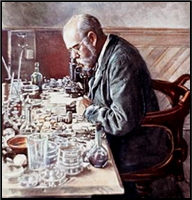 xxxxxPasteur’s major rival, whom he met in London in 1881,
was the German physician Robert Koch
(1843-1910), one of the founders of microbiology. He and his
assistants introduced the techniques for developing bacteria
outside of the body - growing pure cultures of single species
of bacteria in the laboratory - and this enabled them to
pinpoint the bacteria responsible for a number of deadly diseases,
including tuberculosis, cholera and blood poisoning. As we have
seen, it was his discovery of the anthrax bacteria in the late
1870s that assisted
xxxxxPasteur’s major rival, whom he met in London in 1881,
was the German physician Robert Koch
(1843-1910), one of the founders of microbiology. He and his
assistants introduced the techniques for developing bacteria
outside of the body - growing pure cultures of single species
of bacteria in the laboratory - and this enabled them to
pinpoint the bacteria responsible for a number of deadly diseases,
including tuberculosis, cholera and blood poisoning. As we have
seen, it was his discovery of the anthrax bacteria in the late
1870s that assisted 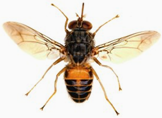 Pasteur
in providing a successful vaccine against this disease. Hexlater confirmed that fleas and rats were responsible
for the transmission of bubonic plague, and that sleeping sickness
was transmitted by the tsetse fly. (Discovered, in fact, by his
one-time colleague, the Scottish microbiologist David Bruce (1855-1931)
in 1903.)
Pasteur
in providing a successful vaccine against this disease. Hexlater confirmed that fleas and rats were responsible
for the transmission of bubonic plague, and that sleeping sickness
was transmitted by the tsetse fly. (Discovered, in fact, by his
one-time colleague, the Scottish microbiologist David Bruce (1855-1931)
in 1903.)
xxxxxIn addition,
Koch pioneered valuable new techniques for conducting experiments
in microbiology - such as the use of dyes to sharpen the
image of bacteria under the microscope - and he laid
down a set of rules, his so-called “postulates”, to determine
whether a particular bacterium was the cause of a specific
disease. In 1891 he was appointed director of the Prussian
Institute for Infectious Diseases (later renamed the Robert Koch
Institute) but, after winning the Nobel Prize for Medicine in
1905, he spent most of his time travelling to many parts of the
world, studying a variety of diseases - such as malaria,
cholera and sleeping sickness - and advising on ways to
combat them.
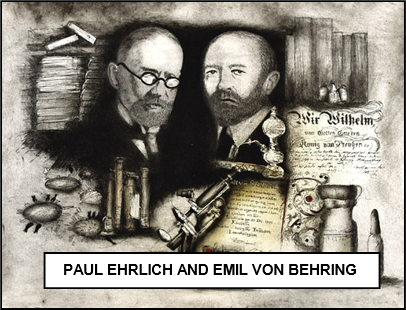 xxxxxOne of Koch’s
assistants was the German immunologist Emil
von Behring (1854-1917). He later
became professor of hygiene at Marburg University, a position he
held for over 20 years. Hexannounced the
discovery of antitoxins in 1890 and, aided by the Japanese
bacteriologist Shibasaburo Kitasato (1852-1931), developed a serum therapy against
diphtheria and tetanus. For
his advances in serum therapeutics - the treatment of disease
by the injection of serum from immune animals - he was
awarded the first Nobel Prize in Medicine in 1901, and his
vaccination techniques against diphtheria and tuberculosis earned
him the title ”Children Saviour”. Inxhis
development of a diphtheria serum Behring was assisted by his
colleague Paul Ehrlich
(1854-1915), the German bacteriologist who later developed
the first antibiotic for the treatment of syphilis, and whose
research into the field of chemotherapy earned him the Nobel Prize
for Medicine in 1908.
xxxxxOne of Koch’s
assistants was the German immunologist Emil
von Behring (1854-1917). He later
became professor of hygiene at Marburg University, a position he
held for over 20 years. Hexannounced the
discovery of antitoxins in 1890 and, aided by the Japanese
bacteriologist Shibasaburo Kitasato (1852-1931), developed a serum therapy against
diphtheria and tetanus. For
his advances in serum therapeutics - the treatment of disease
by the injection of serum from immune animals - he was
awarded the first Nobel Prize in Medicine in 1901, and his
vaccination techniques against diphtheria and tuberculosis earned
him the title ”Children Saviour”. Inxhis
development of a diphtheria serum Behring was assisted by his
colleague Paul Ehrlich
(1854-1915), the German bacteriologist who later developed
the first antibiotic for the treatment of syphilis, and whose
research into the field of chemotherapy earned him the Nobel Prize
for Medicine in 1908.
xxxxxAxnumber of other bacteriologists of this period are
worthy of note. The French-Swiss physician Alexandre
Yersin (1863-1943) worked with
Pierre Roux in the discovery of the diphtheria toxin in 1884, and
in Hong Kong ten years later - along with Shibasaburo
Kitasato - he discovered the bacillus responsible for the
bubonic plague - later named Yersinia
pestis in his honour. ThexGerman
physician Arthur Nicolaier (1862-1942) discovered the tetanus bacterium in
1884, showing that the condition resulted from the contamination
of open wounds with soil bacilli, and in the same year the German
biologist Frederich Loffler (1852-1915), together with his countryman Edwin Klebs (1834-1913)
discovered the organism that causes diphtheria (commonly known as
the Klebs-Loffler bacillus) - at virtually the same time
as Yersin and Roux. Later, in 1897, Loffler discovered the cause
of the virulent foot and mouth disease which affects cloven-hoofed
animals.



 xxxxxAs we have seen, it was in 1858
(Va) that the outstanding French chemist
and microbiologist Louis Pasteur began to study the process of
fermentation in the making of wine. He discovered that this was
caused by microorganisms, and from this finding came the method
known as “pasteurisation”, a controlled heating process for
destroying harmful microscopic life. Further experiments convinced
him that diseases were spread by germs contained in particles of
dust. His theory -
xxxxxAs we have seen, it was in 1858
(Va) that the outstanding French chemist
and microbiologist Louis Pasteur began to study the process of
fermentation in the making of wine. He discovered that this was
caused by microorganisms, and from this finding came the method
known as “pasteurisation”, a controlled heating process for
destroying harmful microscopic life. Further experiments convinced
him that diseases were spread by germs contained in particles of
dust. His theory - xxxxxThe following year Pasteur turned to the study of
anthrax, an acute disease which is primarily a disease of grazing
animals -
xxxxxThe following year Pasteur turned to the study of
anthrax, an acute disease which is primarily a disease of grazing
animals - xxxxxIn April 1882 Pasteur was elected a member of the Académie Française, and it was then that he
began his research to find a preventative treatment for rabies, a
deadly virus which causes inflammation of the brain in warm-
xxxxxIn April 1882 Pasteur was elected a member of the Académie Française, and it was then that he
began his research to find a preventative treatment for rabies, a
deadly virus which causes inflammation of the brain in warm- xxxxxThexsuccessful production of
a vaccine against rabies led directly to the founding of the Pasteur Institute in Paris,
dedicated to the treatment of infectious diseases and, today, one
of the most famous centres of biological research. Built with
money received from public subscriptions, raised worldwide, it was
opened in 1888, and Pasteur served as its director until his death
in 1895. With the assistance of a well-
xxxxxThexsuccessful production of
a vaccine against rabies led directly to the founding of the Pasteur Institute in Paris,
dedicated to the treatment of infectious diseases and, today, one
of the most famous centres of biological research. Built with
money received from public subscriptions, raised worldwide, it was
opened in 1888, and Pasteur served as its director until his death
in 1895. With the assistance of a well- xxxxxPasteur died at Saint-
xxxxxPasteur died at Saint- xxxxxAs we have seen, it was in the 1860s that Pasteur
saved the French silk industry from extinction by finding and
eradicating a harmful parasite. In the 1880s, however, the
industry was again threatened. In 1878 the French chemist Hilaire de Chardonnet (1839-
xxxxxAs we have seen, it was in the 1860s that Pasteur
saved the French silk industry from extinction by finding and
eradicating a harmful parasite. In the 1880s, however, the
industry was again threatened. In 1878 the French chemist Hilaire de Chardonnet (1839- xxxxxPasteur’s major rival, whom he met in London in 1881,
was the German physician Robert Koch
(1843-
xxxxxPasteur’s major rival, whom he met in London in 1881,
was the German physician Robert Koch
(1843- Pasteur
in providing a successful vaccine against this disease. He
Pasteur
in providing a successful vaccine against this disease. He xxxxxOne of Koch’s
assistants was the German immunologist Emil
von Behring (1854-
xxxxxOne of Koch’s
assistants was the German immunologist Emil
von Behring (1854-


